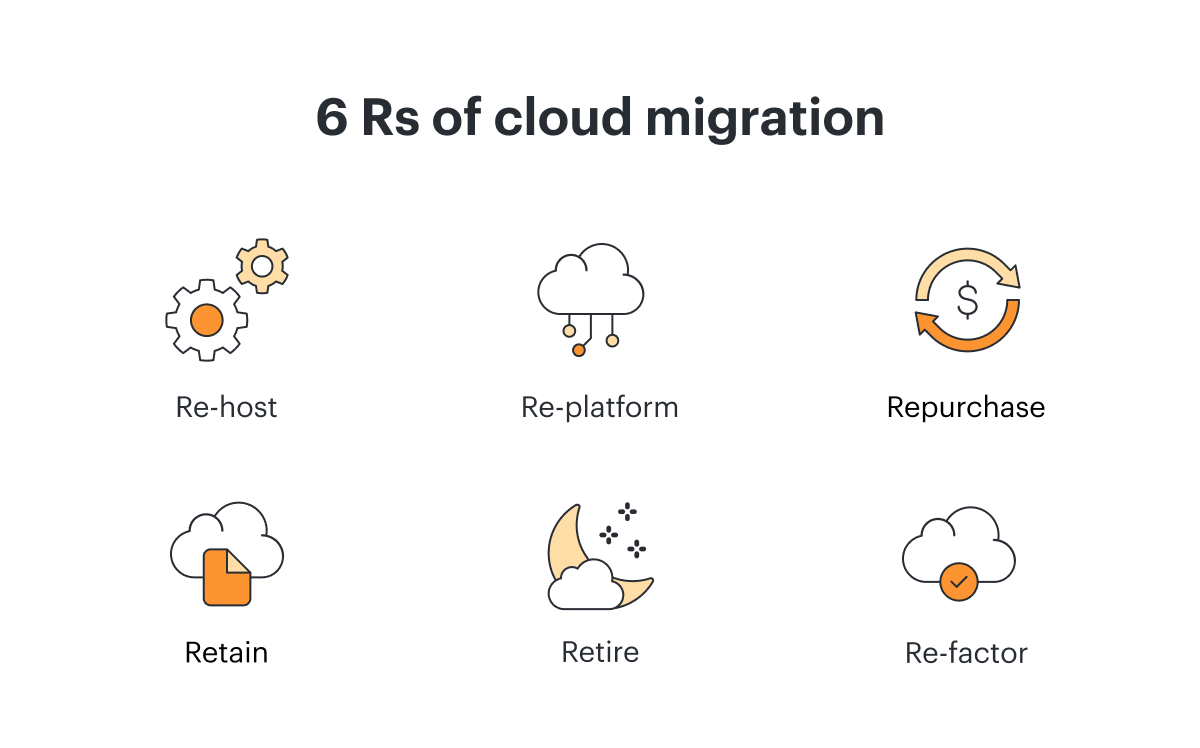
Cloud migration strategies: The 6 Rs of cloud migration
Reading time: about 5 min
Topics:
A cloud migration strategy is your plan for moving data, applications, and other digital assets from on-premise to a cloud architecture. It’s possible that not everything in your business workload needs to be moved to the cloud. So part of your migration strategy needs to identify the specific type of data and digital assets you want to move into a cloud computing environment. You’ll also want to prioritize what is most important so you can decide what needs to be transferred first.
In this article we’ll discuss a model of cloud migration strategies known as the 6 Rs.
What are the steps of a cloud migration strategy?
Your migration process will vary depending on your type of business and the size of your company. But no matter which method you decide to use in your migration process, your cloud migration strategy should include these basic steps:
- Plan the migration. You need to understand your current environment, why you are migrating to the cloud, determine your cloud server requirements, security requirements, and so on.
- Choose a cloud environment. Choose the cloud environment you want to use: public cloud, hybrid cloud, private cloud, or multi cloud.
- Migrate your apps and data. If your plan is effective, moving apps and data to the cloud should go smoothly.
- Validate the migration. Your cloud migration isn’t successful just because all the data was transferred. To be a success, you have to analyze everything and make sure that everything works as expected.
As you go through the process, you’ll want to make sure that your current system remains up and running. You don’t want to have any interruptions to the normal workflow during the migration.

Executing your cloud migration strategy should be a team effort. Make sure you put together the right team to make your migration a success.
Learn moreWhat are the 6 Rs of cloud migration?
Every cloud migration will be different, so each will need a clear migration strategy. The 6 Rs of cloud migration—re-host, re-platform, repurchase, retain, retire, and re-factor—can help you to determine clear paths for your migration. You can look at each “R” as a separate migration strategy. But that does not mean that the 6 Rs are definitive or the only way to develop your migration plan. Instead, think of the 6 Rs as a framework for discussion or a blueprint for determining your cloud migration guidelines.

Re-host
Also sometimes called “lift and shift,” this is a basic strategy that involves lifting the stuff you currently host on-premise and shifting it to the cloud. You move an exact copy of your current environment to the same type of environment on the cloud. This strategy usually does not require extensive reconfigurations or changes to architecture. Everything that worked in the on-premise environment should work the same way when hosted on the cloud.
This strategy is good for companies that are new to cloud migration and are building trust in the cloud. Because there are not a lot of differences between their current environment and the cloud environment, there’s not a huge investment with the re-hosting strategy.
Re-platform
This one is similar to a lift and shift strategy. The difference is that you will make some more changes and adjustments to applications so they are optimized and will work better and faster when hosted on the cloud. Re-platforming requires programming knowledge so that your current environment integrates seamlessly with the cloud environment.
This strategy is also good for companies that are still testing the cloud migration waters and want to build trust in the cloud while seeing benefits like faster system performance and lower costs.
Repurchase
With repurchasing, you are moving your environment to a new, cloud-based product. One way to do this is to abandon your current applications and replace them with software as a service (SaaS) options. This can be a challenge because team members lose the familiarity with your existing apps and will need to be trained on the new platform.
Another way to go with the repurchase strategy is to move licenses from local servers to cloud-based servers. For example, you might move a customer relationship management system (CRM) to Salesforce.
The repurchasing strategy might be a good, cost-effective way to go if you are moving applications from customized legacy environments.
Retain
If migrating to the cloud doesn’t make sense for your company at this time, you can retain your current environment and revisit a move to the cloud later. For example, to be in compliance, you can’t move data at this time. Or, some of your applications might be too difficult to migrate and you want to keep them until you can come up with a viable and cost-effective alternative.
In this case, you might want to look at a hybrid option with some of your stuff retained on-premise while others are moved to the cloud.
Retire
Some of your applications and services might not be useful anymore. There’s no reason to migrate them to the cloud if they are not going to be of value to your customers. If this is the case, all you need to do is turn them off.
Re-factor
This strategy can be labor-intensive because it involves redesigning and building your existing applications from scratch so they can work in the cloud environment. Re-factoring can be time-consuming and expensive. But by taking the time to re-factor your applications, they will be more compatible with future versions, and it can make them more accessible to accommodate future growth.
It’s likely that your company won’t use all of these strategies. The 6 Rs of cloud migration are meant to be used as a guide to help you determine which path is best for your company’s cloud migration needs.

Want to learn more about executing a successful cloud migration strategy?
See this checklistAbout Lucidchart
Lucidchart, a cloud-based intelligent diagramming application, is a core component of Lucid Software's Visual Collaboration Suite. This intuitive, cloud-based solution empowers teams to collaborate in real-time to build flowcharts, mockups, UML diagrams, customer journey maps, and more. Lucidchart propels teams forward to build the future faster. Lucid is proud to serve top businesses around the world, including customers such as Google, GE, and NBC Universal, and 99% of the Fortune 500. Lucid partners with industry leaders, including Google, Atlassian, and Microsoft. Since its founding, Lucid has received numerous awards for its products, business, and workplace culture. For more information, visit lucidchart.com.
Related articles
Overcoming the most common cloud migration challenges
As more organizations switch to cloud computing, learn about the common cloud migration challenges and ways to solve them.
Creating a holistic cloud security strategy
In this article, we’ll walk you through how to establish a holistic approach to cloud security including how to use visuals to align teams on best security practices and clearly see your cloud environment.
